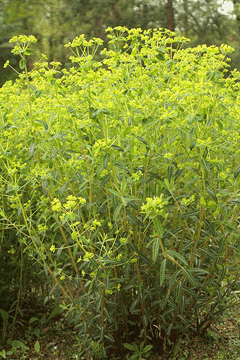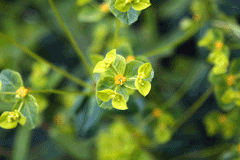 |
|
http://commons.wikimedia.org/wiki/User:Dalgial |
 |
| http://commons.wikimedia.org/wiki/User:Dalgial |
Translate this page:
Summary
Physical Characteristics

 Euphorbia pekinensis is a PERENNIAL growing to 0.6 m (2ft). It is in flower from May to July. The species is hermaphrodite (has both male and female organs) and is pollinated by Insects.
Euphorbia pekinensis is a PERENNIAL growing to 0.6 m (2ft). It is in flower from May to July. The species is hermaphrodite (has both male and female organs) and is pollinated by Insects.
Suitable for: light (sandy) and medium (loamy) soils and prefers well-drained soil. Suitable pH: mildly acid, neutral and basic (mildly alkaline) soils. It cannot grow in the shade. It prefers dry or moist soil.
UK Hardiness Map
US Hardiness Map
Synonyms
Plant Habitats
Cultivated Beds;
Edible Uses
References More on Edible Uses
Medicinal Uses
Plants For A Future can not take any responsibility for any adverse effects from the use of plants. Always seek advice from a professional before using a plant medicinally.
Antibacterial Diuretic Epilepsy Purgative Vasodilator
Da Ji is classified as a toxic herb in Chinese medicine and so is only prescribed for relatively serious diseases[254]. It is considered to be one of the 50 fundamental herbs[218] and is used as a cathartic to purge excess fluids in conditions such as pleurisy and ascites and for the treatment of kidney problems, especially nephritis[254]. Research has shown that it is therapeutically useful in the treatment of ascites and nephritis, but it does produce significant side-effects[254]. It should only be used under the supervision of a qualified herbalist[254]. The root is antibacterial, diuretic, emetic, emmenagogue, purgative and vasodilator[176, 218, 238]. It is used in the treatment of oedema, fullness of the chest, sticky sputum, epilepsy, carbuncle and tubercle[176]. When used in conjunction with liquorice (Glycyrrhiza species) the diuretic and purgative actions are inhibited[176]. Another report says that the plant is incompatible with liquorice because it neutralizes their medicinal effects[254]. Externally, it is applied to inflamed sores to reduce swelling[254].
References More on Medicinal Uses
The Bookshop: Edible Plant Books
Our Latest books on Perennial Plants For Food Forests and Permaculture Gardens in paperback or digital formats.

Edible Tropical Plants
Food Forest Plants for Hotter Conditions: 250+ Plants For Tropical Food Forests & Permaculture Gardens.
More

Edible Temperate Plants
Plants for Your Food Forest: 500 Plants for Temperate Food Forests & Permaculture Gardens.
More

More Books
PFAF have eight books available in paperback and digital formats. Browse the shop for more information.
Shop Now
Other Uses
References More on Other Uses
Cultivation details
We have very little information on this species and do not know if it will be hardy in Britain, though judging by its native range it should succeed outdoors in most parts of this country. It is a polymorphic species[58]. The following notes are based on the general needs of the genus. Prefers a light well-drained moderately rich loam in an open position[200]. Succeeds in dry soils[1]. Hybridizes with other members of this genus[200]. The ripe seed is released explosively from the seed capsules[200]. Members of this genus are rarely if ever troubled by browsing deer or rabbits[233]. This genus has been singled out as a potential source of latex (for making rubber) for the temperate zone, although no individual species has been singled out[141].
References Carbon Farming Information and Carbon Sequestration Information
Temperature Converter
Type a value in the Celsius field to convert the value to Fahrenheit:
Fahrenheit:
The PFAF Bookshop
Plants For A Future have a number of books available in paperback and digital form. Book titles include Edible Plants, Edible Perennials, Edible Trees,Edible Shrubs, Woodland Gardening, and Temperate Food Forest Plants. Our new book is Food Forest Plants For Hotter Conditions (Tropical and Sub-Tropical).
Shop Now
Plant Propagation
Seed - sow spring in a cold frame. When they are large enough to handle, prick the seedlings out into individual pots and grow them on in the greenhouse for at least their first winter. Plant them out into their permanent positions in late spring or early summer, after the last expected frosts.
Other Names
If available other names are mentioned here
Native Range
TEMPERATE ASIA: China (widespread), Korea, Japan (Honshu, Kyushu, Shikoku)
Weed Potential
Right plant wrong place. We are currently updating this section.
Please note that a plant may be invasive in one area but may not in your area so it's worth checking.
Conservation Status
IUCN Red List of Threatened Plants Status :

| Related Plants
|
| Latin Name | Common Name | Habit | Height | Hardiness | Growth | Soil | Shade | Moisture | Edible | Medicinal | Other |
| Acalypha australis | Asian copperleaf | Annual | 0.5 |
0-0
| | LMH | SN | M | 0 | 1 | |
| Alchornea castaneifolia | Iporuru | Tree | 8.0 |
10-12
| F | LMH | SN | MWe | 0 | 4 | 2 |
| Alchornea cordifolia | Christmas Bush | Shrub | 8.0 |
10-12
| M | LMH | N | DMWe | 2 | 4 | 3 |
| Aleurites cordata | Japan Wood-Oil Tree | Tree | 7.0 |
9-11
| | LM | SN | M | 0 | 0 | 2 |
| Aleurites fordii | Tung Tree, Tung Oil Tree, Wood Oil Tree China | Tree | 7.0 |
8-10
| F | LM | SN | M | 1 | 3 | 3 |
| Aleurites moluccanus | Candle Nut, Country Walnut | Tree | 20.0 |
10-12
| F | LMH | N | DM | 3 | 3 | 4 |
| Caryodendron orinocense | Taccy Nut, Nuez de Barinas | Tree | 25.0 |
10-12
| F | LMH | N | M | 3 | 1 | 2 |
| Chrozophora tinctoria | Dyer's Croton, Giradol | Perennial | 0.0 |
0-0
| | LMH | SN | M | 1 | 0 | 2 |
| Cnidoscolus aconitifolius | Tree Spinach, Tread Softly, Cabbage Star, Chaya | Shrub | 5.0 |
9-11
| F | LMH | SN | M | 4 | 3 | 3 |
| Cnidoscolus elasticus | Highland chilte | Shrub | 1.0 |
9-11
| F | LMH | N | DM | 0 | 0 | 4 |
| Croton lechleri | Sangre De Grado, Dragon's blood | Tree | 12.0 |
10-12
| F | LMH | N | M | 0 | 4 | 1 |
| Croton megalocarpus | Croton tree | Tree | 25.0 |
10-12
| F | LM | N | M | 0 | 2 | 4 |
| Croton palanostigma | Sangre De Grado, Dragon's blood | Tree | 12.0 |
10-12
| F | LM | N | M | 0 | 4 | 2 |
| Croton salutaris | Sangre De Grado, Dragon's blood | Tree | 12.0 |
10-12
| F | LM | N | M | 0 | 4 | 0 |
| Croton tiglium | Croton Oil Plant. Croton, Purging croton. | Tree | 7.0 |
10-12
| M | LMH | N | DM | 0 | 3 | 2 |
| Euphorbia abyssinica | Candelabra Spurge | Tree | 7.5 |
10-12
| M | LM | SN | D | 0 | 2 | 3 |
| Euphorbia antisyphilitica | Candelilla | Shrub | 1.0 |
7-10
| | LM | N | DM | 2 | 0 | 4 |
| Euphorbia corollata | Wild Spurge, Flowering spurge | Perennial | 1.0 |
4-8
| | LM | SN | DM | 0 | 2 | 2 |
| Euphorbia drummondii | Caustic Weed | Annual | 0.2 |
-
| | LM | N | DM | 0 | 1 | |
| Euphorbia esula | Leafy Spurge. Green spurge | Perennial | 1.0 |
3-9
| F | LMH | SN | DM | 0 | 0 | 4 |
| Euphorbia helioscopia | Madwoman's Milk | Annual | 0.4 |
-
| | LM | N | DM | 1 | 2 | |
| Euphorbia hirta | Asthma Weed, Pill-Bearing Spurge | Annual | 0.3 |
-
| | LM | N | DM | 1 | 3 | |
| Euphorbia humifusa | | Annual | 0.2 |
-
| | LM | N | DM | 1 | 2 | |
| Euphorbia intisy | Intisy, Pencil Plant | Shrub | 5.0 |
10-12
| F | LM | SN | D | 0 | 0 | 3 |
| Euphorbia ipecacuanhae | American Ipec | | 0.0 |
-
| | LMH | SN | M | 0 | 1 | |
| Euphorbia lactea | Mottled Spurge | Shrub | 5.0 |
10-11
| M | LMH | SN | DM | 0 | 0 | 4 |
| Euphorbia lathyris | Caper Spurge, Moleplant | Annual/Biennial | 1.0 |
5-9
| | LMH | SN | DM | 1 | 2 | 3 |
| Euphorbia marginata | Mountain Snow, Ghost Spurge, Ghost Weed | Annual | 0.6 |
4-8
| F | LM | N | DM | 1 | 1 | 3 |
| Euphorbia neriifolia | Fleshy spurge, Hedge Euphorbia, Oleander spurge | Shrub | 4.0 |
10-12
| F | LM | SN | D | 2 | 2 | 2 |
|
|
Growth: S = slow M = medium F = fast. Soil: L = light (sandy) M = medium H = heavy (clay). pH: A = acid N = neutral B = basic (alkaline). Shade: F = full shade S = semi-shade N = no shade. Moisture: D = dry M = Moist We = wet Wa = water.
Now available:
Food Forest Plants for Mediterranean Conditions
350+ Perennial Plants For Mediterranean and Drier Food Forests and Permaculture Gardens.
[Paperback and eBook]
This is the third in Plants For A Future's series of plant guides for food forests tailored to
specific climate zones. Following volumes on temperate and tropical ecosystems, this book focuses
on species suited to Mediterranean conditions—regions with hot, dry summers and cool, wet winters,
often facing the added challenge of climate change.
Read More
Expert comment
Author
Rupr.
Botanical References
58275
Links / References
For a list of references used on this page please go here
Readers comment
| Add a comment |
|
If you have important information about this plant that may help other users please add a comment or link below. Only comments or links that are felt to be directly relevant to a plant will be included. If you think a comment/link or information contained on this page is inaccurate or misleading we would welcome your feedback at [email protected]. If you have questions about a plant please use the Forum on this website as we do not have the resources to answer questions ourselves.
* Please note: the comments by website users are not necessarily those held by PFAF and may give misleading or inaccurate information.
To leave a comment please Register or login here All comments need to be approved so will not appear immediately.
|
Subject : Euphorbia pekinensis
|
|
|
|